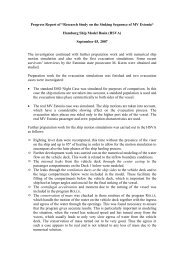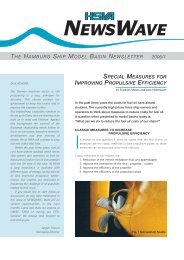You also want an ePaper? Increase the reach of your titles
YUMPU automatically turns print PDFs into web optimized ePapers that Google loves.
CALCULATION OF<br />
HYDRODYNAMIC BODY<br />
FORCE COEFFICIENTS FOR<br />
TThe motion of a ship can be predicted if the hydrodynamic forces on the<br />
hull, rudder and propeller are known. The forces are a function of ship<br />
velocity and acceleration (higher order time-derivatives can usually be<br />
neglected). With a polynomial approach like:<br />
the time dependent forces can be calculated. The unknown coefficients are determined<br />
either by model-testing or calculations. A sufficiently accurate set of these<br />
coefficients is vital for a reliable prediction of the manoeuvring capabilities and<br />
thus for the design of the manoeuvring devices like rudder and thrusters in an early<br />
state of the design process.<br />
Since 1 st January 2005 the European Integrated Project (IP) VIRTUE,<br />
“The Virtual Tank Utility in Europe” works on advanced numerical simulation tools.<br />
“The Numerical Manoeuvring Tank”, being one of the 4 different CFD development<br />
fields in the project, focuses on numerical manoeuvring predictions. Within this<br />
work package a major task is a substantial improvement in accuracy, efficiency and<br />
consistency of computations for simple modes of motion like steady drift and rotation.<br />
Fig. 1 Forces and Moments on<br />
the “Hamburg Test Case”<br />
at 1.05 m/s model speed<br />
4 <strong>NEWSWAVE</strong> 2006/2<br />
News from the VIRTUE labs<br />
MANOEUVRING PREDICTIONS<br />
by Marco Schneider<br />
X=Xu u+X 2 u u u2 u+Xu u+Xu 2u 2 +Xυ 2υ 2 +Xr 2r 2 • •<br />
• •<br />
+...<br />
Fig. 2 Forces and Moments on<br />
the “Hamburg Test Case”<br />
at 1.89 m/s model speed<br />
Wake field of the<br />
“Hamburg Test Case”<br />
at 30° drift angle<br />
Comprehensive investigations on<br />
numerical discretisation, turbulence<br />
modelling, free surface flow and scale<br />
effects are performed that yield recommendations<br />
for practical applications.<br />
Based on these developments <strong>HSVA</strong><br />
sets out to deliver CFD based manoeuvring<br />
coefficients.<br />
Figure1 shows the comparison of<br />
the calculated non-dimensional forces<br />
and moments at different drift angles<br />
and velocities of the “Hamburg Test<br />
Case” with experiments. The calculations<br />
were performed with the<br />
Reynolds-Averaged Navier-Stokes<br />
Equations (RANSE) solver Comet. In a<br />
first approach the deformation of the<br />
free surface at speed was neglected.<br />
A double body model that uses a<br />
symmetry plane located at the undisturbed<br />
free surface has been employed.<br />
At lower ship speeds the double body<br />
model gives good agreements between<br />
experiment and simulation for the X<br />
and Y forces and the N moment. At<br />
higher speed the hydrostatic pressure<br />
generated by the bow wave (shown in<br />
Figure3) has a significant influence on<br />
the forces and thus cannot be neglected<br />
any more. Here the volume of fluid<br />
(VOF) free-surface model implemented<br />
in Comet was used to predict the forces<br />
and moments more accurately (shown<br />
in Figure2) at the cost of a significant<br />
increase of the computation time.





